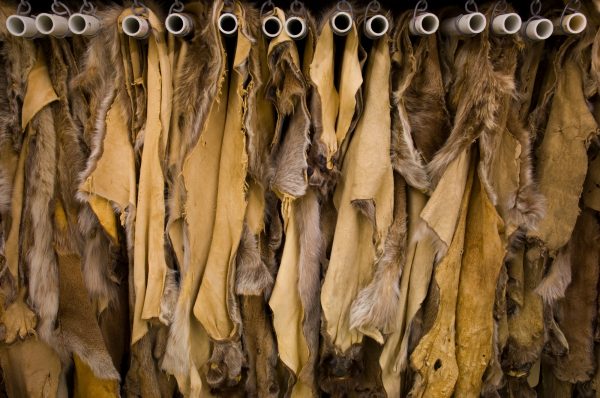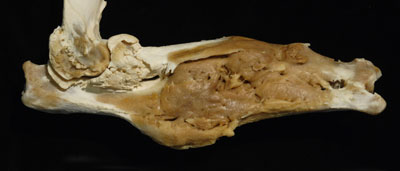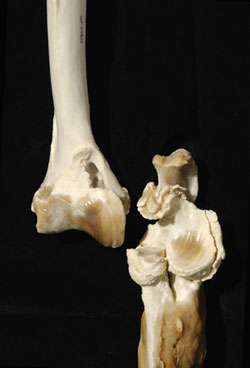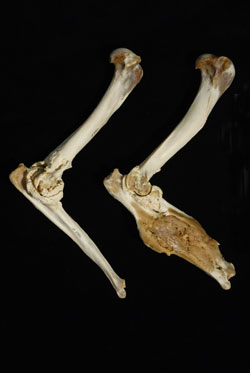
Florida Museum photo by Eric Zamora
Florida Museum of Natural History scientists are fine-tuning conservation knowledge about endangered Florida panthers by studying their bones and pelts. Researchers recently concluded two pilot studies: one examined the presence of Harris lines, or growth-arrest lines, detectable by radiography in panther long bones and the presence of bone diseases, such as arthritis. The second study analyzed what panthers eat by looking at certain naturally occurring elements in their bone collagen.
The Florida Museum’s mammalogy collection houses about 140 panther specimens in the form of skeletons with associated skins. In the wild, when the carnivores die naturally or are road-killed on our highways, the Fish and Wildlife Conservation Commission attempts to recover their bodies. If successful, the carcasses are necropsied by the FWC, and sent to our museum where staff curates the animal by preserving its bones and skin.
The resulting specimens are invaluable reservoirs of data, because long after an animal dies, its bones, hair and skin still contain details about its life. Scientists use different methods to extract these details and learn about the animal’s nutrition or the illnesses, injuries and disease it faced over its life.

Photo by Jeff Gage
One study led by Mammalogy Collections Manager Laurie Wilkins examined growth-arrest lines in long bones from about 100 panthers. Growth-arrest lines are thought to represent periods of stress in young animals—induced by malnutrition or disease—when the bones stop, and then start, growing. Fine, white lines appear in long bone radiographs of animals with this condition. Although the concept is somewhat controversial, the conventional line of thought holds that the presence of growth-arrest lines in a long bone correlates to malnutrition stress in a young animal. Scientists believe growth-arrest lines in older animals are a reflection of the conditions the animal faced while it was growing.
“The study of Harris lines was pioneered by researchers from UCLA in 1995,” Wilkins said. “But we now have a more robust sample with our rich resource of specimens collected over a time period that includes habitat improvement, genetic restoration and health monitoring by FWC wildlife biologists.”

Photo by Jeff Gage
The panther specimens in Wilkins’ study come from nearly the full geographic range of panthers in southern Florida, and span back to individuals that lived up to 25 years ago, back to the time when studies and tracking of the remnant population of Florida puma began. The time period Wilkins and her colleagues used for their samples reveals a “before” and “after” snapshot of panther health from when five female Texas panthers were introduced to Florida in 1995. The Texas cats injected more genetic variation into the small and increasingly inbred Florida population.
Wilkins found that older cats had a higher frequency of growth-arrest lines than the younger cats from the sample. Those 6 months old or less had the lowest frequency and male cats had a lower frequency of growth-arrest lines than females. Because these stress lines cannot form once the animal stops growing, between 2 and 3 years of age, Wilkins interpreted these results to mean that the older cats had a comparatively more stressful adolescence than the ones represented by the youngest specimens in their sample. Historical Florida Fish and Wildlife Conservation Commission capture data suggests cats in certain areas of Florida were in poor health during the 1980s. She stressed the results would only be useful with a larger sample when they could be compared to future generations.
Further analysis of the panther skeletons also revealed a high incidence of bone diseases, such as arthritis. Wilkins said that some cases were severe and studies are underway to examine possible causes.
“There is a lot of work to be done as we attempt to correlate skeletal pathologies and dietary information to life history parameters such as age, parentage, genetic profile, habitat and recorded health incidents,” Wilkins said. “We believe this information will augment that being gathered on living animals and provide another management tool for panther biologists.”
A second, related study looked at differences in what panthers eat and how this changes across their geographical ranges, and over time. To do this, scientists measured carbon and nitrogen isotopes preserved in bone collagen. Isotopes are atoms of naturally occurring elements, characterized by varying numbers of neutrons but a constant number of protons. Carbon and nitrogen isotopes are typically used to assess animal diets. The old adage, “you are what you eat” proves true, because the nitrogen and carbon isotope ratios present in an animal reflect what sorts of food it has eaten and assimilated into its bones and tissues. By examining the isotope signatures of the animal and its possible prey, the researchers are able to make predictions about what panthers may have eaten. Nitrogen signatures signal the level of the food web at which the animal is feeding (for example, a top carnivore that feeds on herbivores) and carbon signatures fine-tune and differentiate between prey sources—in particular, they tell what types of plants a herbivore was eating, such as fibrous bushes or grass.

Photo by Jeff Gage
Julie Allen, a zoology graduate student and Florida Museum researcher, said the isotope study turned up some surprising differences between male and female diets, as well as the diets of panthers north and south of Interstate 75. The northern panthers held isotopic signatures suggesting they might be eating more small prey than expected, such as raccoons and armadillos, rather than deer and hogs. Interestingly, all the northern panthers with this unique signature were also male.
“The historical data we have associated with these northern males show that they may have been sick,” Allen said. “One in particular died of a bacterial infection. So it makes sense that if they were unhealthy, they wouldn’t be going after larger prey.”
Allen said that the isotope signatures of the female panthers were consistent with a diet of mostly deer and hog, while male panthers appeared to be eating those items plus possibly other small mammals like armadillo and raccoons. It’s possible that male panther diets differ because they range more widely and come into contact with many different types of prey, but Allen stressed that the small sample size precluded making broad generalizations about panther diets and needs.
“This was a pilot study to test the usefulness of isotopes in assessing panther diet, and it was successful in that sense,” Allen said. “However, in future studies we need to refine the isotopes for our prey bases by including more animals, and we need to sample more panthers to see if our trends hold.”
Shelley Flanagin, a UF undergraduate at the time of the study, assisted with lab work and writing of the paper.
“The information we can get from museum specimens is fascinating,” Flanagin said. “It’s particularly useful for conservation efforts because we can gather data that would be practically impossible to collect from the endangered wild animals.”
Florida panthers are one of the most imperiled mammals on the planet. They once roamed large swaths of the southeast, but disappearing habitat eventually squeezed these top predators down to Florida’s peninsular southern tip. Today, fewer than 80 of the 250-pound cats slink and stalk through our state’s low pinelands, palm forests and swamps. But researchers at the Florida Museum hope that their work will contribute to recovering this endangered carnivore and conserve it for future generations.
The Florida Museum acquires panther specimens through a cooperative salvage program with the Florida Fish and Wildlife Conservation Commission, in effect since the early 1980s. No panthers were killed or harmed for these studies.
Learn more about the Florida panther at floridapanthernet.org with the Florida Fish and Wildlife Conservation Commission.